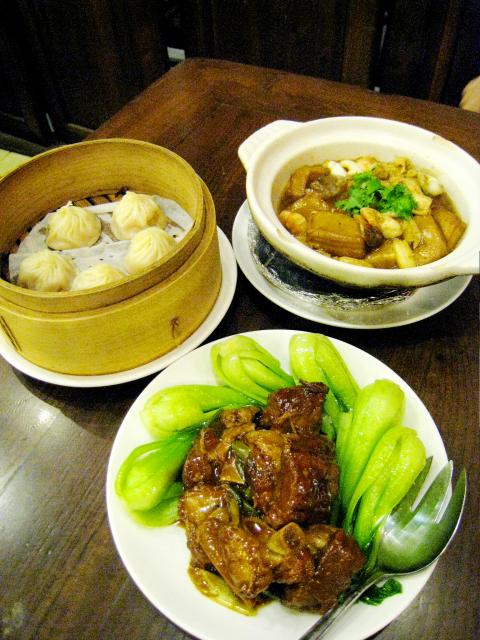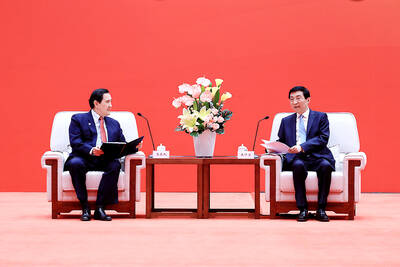The Taipei Times first reviewed Dian Shui Lou when it was launched in 2003 by Namchow Group (南僑集團), a soap-making chemical manufacturer-cum-culinary giant. Over the years, the establishment has grown from a humble business promoting Jiangzhe cuisine (江浙菜) to a high-profile restaurant chain that enjoys widespread recognition. Last year, it was crowned as the only restaurant to be awarded the full five stars by the Northern Taiwan Restaurant Guide (北台灣餐館評鑑). Din Tai Fung (鼎泰豐) received three.
In light of the recent development, I visited the branch on the 11th floor of the Fuxing Sogo department store in Taipei. An initial survey of the restaurant’s old-school screens and lanterns recalled the Chinese restaurants my parents took me to when I was a child. Clearly, the design is modeled on tradition, but with a neater look. The service also had a nostalgic feel to it, as the uniformed waitstaff appeared to know exactly what they should do and how to do it efficiently, but without any smiles or any traces of enthusiasm.
Fortunately, Dian Shui Lou’s food scores better than the friendliness of its staff. The xiaolongbao (小籠包, NT$110 for a steamer of five), or “steamed dumplings,” on Dian Shui Lou’s menu, are rolled up in thin wrappers that nevertheless have a pleasant spring when you bite into them for a mouthful of rich, ambrosial juice.

Photo: Ho Yi, Taipei Times:
Also on the Shanghai-style dim sum section is pan-fried wild vegetable pancake (薺菜鍋餅, NT$280). Using shepherd’s purse, or jicai (薺菜), common in Shanghai and neighboring areas, the pancake is one of the restaurant’s specialties, but excepting the fragrantly roasted sesame seeds sprinkled on top, it didn’t make an impression.
For a main course, my dining companion and I ordered a few items from a selection of favorite dishes listed on the menu. The braised tender pork ribs with vegetable and plum sauce (無錫排骨, NT$420) quickly won my heart when a light touch of my chopsticks caused the meat to slip off the bone. The lean meat was cooked to a tender perfection, and the velvety fat added melt-in-the-mouth deliciousness. Both were pleasantly soaked in the sweet, savory sauce.
Equally delicious was the braised specialty tofu with seafood and pork (點水豆腐煲, NT$480), made up of mushroom, pork, crab meat, shrimp, slices of sea cucumber and tofu. The dish had a nice oceanic aroma, and like all the food I sampled, was delightfully lighter in taste than the rich Jiangzhe fare at similar establishments in Taipei.
The boiled chicken consomme (元盅土雞清湯, NT$195) was also light and savory, and devoid of the unattractive tang common to boiled chicken.
Overall, the food at Dian Shui Lou was good enough to make me want to return, but the restaurant lacks a sense of refinement that one associates with a five-star culinary experience. For those curious about the restaurant guide mentioned above, it is said to be the country’s answer to Michelin’s Red Guide and has been issued annually by Diet Journal (飲食雜誌) since 2007.
Those who plan to go should also note that most dishes come in large, medium and small. Prices listed in this review are for small portions, which are enough for two. The restaurant has four branches in Taipei and one in Taoyuan. For more information, visit www.dianshuilou.com.tw.

The canonical shot of an East Asian city is a night skyline studded with towering apartment and office buildings, bright with neon and plastic signage, a landscape of energy and modernity. Another classic image is the same city seen from above, in which identical apartment towers march across the city, spilling out over nearby geography, like stylized soldiers colonizing new territory in a board game. Densely populated dynamic conurbations of money, technological innovation and convenience, it is hard to see the cities of East Asia as what they truly are: necropolises. Why is this? The East Asian development model, with

Desperate dads meet in car parks to exchange packets; exhausted parents slip it into their kids’ drinks; families wait months for prescriptions buy it “off label.” But is it worth the risk? “The first time I gave him a gummy, I thought, ‘Oh my God, have I killed him?’ He just passed out in front of the TV. That never happens.” Jen remembers giving her son, David, six, melatonin to help him sleep. She got them from a friend, a pediatrician who gave them to her own child. “It was sort of hilarious. She had half a tub of gummies,

The wide-screen spectacle of Formula One gets a gleaming, rip-roaring workout in Joseph Kosinski’s F1, a fine-tuned machine of a movie that, in its most riveting racing scenes, approaches a kind of high-speed splendor. Kosinski, who last endeavored to put moviegoers in the seat of a fighter jet in Top Gun: Maverick, has moved to the open cockpits of Formula One with much the same affection, if not outright need, for speed. A lot of the same team is back. Jerry Bruckheimer produces. Ehren Kruger, a co-writer on Maverick, takes sole credit here. Hans Zimmer, a co-composer previously, supplies the thumping

There is an old British curse, “may you live in interesting times,” passed off as ancient Chinese wisdom to make it sound more exotic and profound. We are living in interesting times. From US President Donald Trump’s decision on American tariffs, to how the recalls will play out, to uncertainty about how events are evolving in China, we can do nothing more than wait with bated breath. At the cusp of potentially momentous change, it is a good time to take stock of the current state of Taiwan’s political parties. As things stand, all three major parties are struggling. For our examination of the